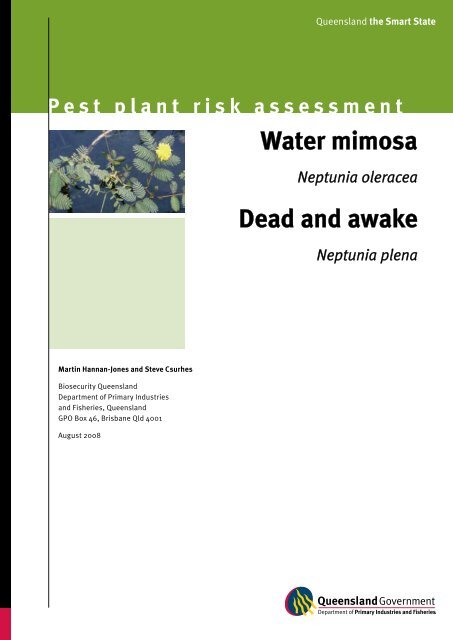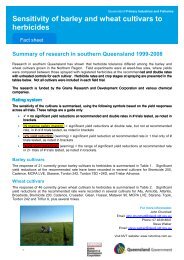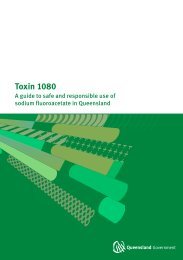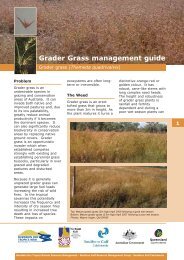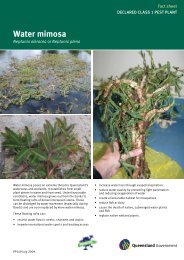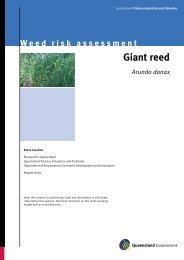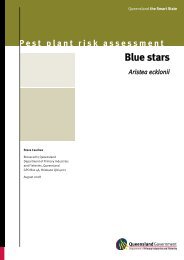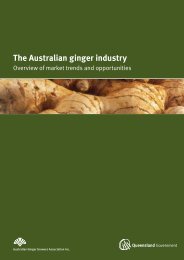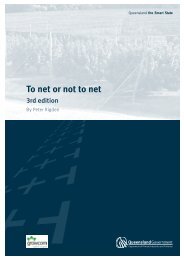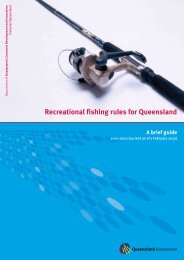Water mimosa—Neptunia oleracea - Department of Primary Industries
Water mimosa—Neptunia oleracea - Department of Primary Industries
Water mimosa—Neptunia oleracea - Department of Primary Industries
You also want an ePaper? Increase the reach of your titles
YUMPU automatically turns print PDFs into web optimized ePapers that Google loves.
Queensland the Smart State<br />
Pest plant risk assessment<br />
Martin Hannan-Jones and Steve Csurhes<br />
Biosecurity Queensland<br />
<strong>Department</strong> <strong>of</strong> <strong>Primary</strong> <strong>Industries</strong><br />
and Fisheries, Queensland<br />
GPO Box 46, Brisbane Qld 4001<br />
August 2008<br />
<strong>Water</strong> mimosa<br />
Neptunia <strong>oleracea</strong><br />
Dead and awake<br />
Neptunia plena
PR08–3686<br />
The <strong>Department</strong> <strong>of</strong> <strong>Primary</strong> <strong>Industries</strong> and Fisheries (DPI&F) seeks to maximise the economic<br />
potential <strong>of</strong> Queensland’s primary industries on a sustainable basis.<br />
While every care has been taken in preparing this publication, the State <strong>of</strong> Queensland<br />
accepts no responsibility for decisions or actions taken as a result <strong>of</strong> any data, information,<br />
statement or advice, expressed or implied, contained in this report.<br />
© The State <strong>of</strong> Queensland, <strong>Department</strong> <strong>of</strong> <strong>Primary</strong> <strong>Industries</strong> and Fisheries 2008.<br />
Copyright protects this material. Except as permitted by the Copyright Act 1968 (Cwlth),<br />
reproduction by any means (photocopying, electronic, mechanical, recording or otherwise),<br />
making available online, electronic transmission or other publication <strong>of</strong> this material is<br />
prohibited without the prior written permission <strong>of</strong> the <strong>Department</strong> <strong>of</strong> <strong>Primary</strong> <strong>Industries</strong> and<br />
Fisheries, Queensland.<br />
Inquiries should be addressed to copyright@dpi.qld.gov.au (tel: +61 7 3404 6999), or:<br />
Director<br />
Intellectual Property Commercialisation Unit<br />
<strong>Department</strong> <strong>of</strong> <strong>Primary</strong> <strong>Industries</strong> and Fisheries<br />
GPO Box 46<br />
Brisbane Qld 4001<br />
Front cover: Neptunia plena inflorescence and leaves.
Contents<br />
Identity and taxonomy 2<br />
Neptunia <strong>oleracea</strong> Lour. 2<br />
Neptunia plena (L.) Benth. 2<br />
Taxonomy and genetics 2<br />
Descriptions (from Windler 1966) 3<br />
Neptunia <strong>oleracea</strong> 3<br />
Neptunia plena 4<br />
Reproduction and dispersal 5<br />
Seed longevity 5<br />
Origin 5<br />
History <strong>of</strong> introduction 5<br />
Worldwide distribution 6<br />
Neptunia <strong>oleracea</strong> 6<br />
Neptunia plena 7<br />
Distribution in Australia 8<br />
Preferred habitat and climate 9<br />
History as a weed overseas and interstate 9<br />
Impact 10<br />
N 2 fixation 10<br />
Effect on water resources 10<br />
Economic benefits 10<br />
Ponded pasture 10<br />
Horticultural crop 11<br />
Herbal medicine 11<br />
Pest potential in Queensland 12<br />
Biological control 12<br />
References 13<br />
Pest plant risk assessment:<br />
<strong>Water</strong> mimosa Neptunia <strong>oleracea</strong><br />
Dead and awake Neptunia plena<br />
1
Identity and taxonomy<br />
Neptunia <strong>oleracea</strong> Lour.<br />
Synonyms: Acacia lacustris Desf., Desmanthus lacustris Willd., D. natans Willd., D.<br />
stolonifer DC, Mimosa aquatica Pers., M. lacustris H. and B., M. natans<br />
L.f., M. prostrata Lam., Neptunia natans (L.f.) Druce, N. prostrata (Lam.)<br />
Baillon, N. stolonifera Guillemin.<br />
Common names: <strong>Water</strong> mimosa, water sensitive plant, garden puff (United States),<br />
neptunie potegère (France), juqueri manso, malicia de agua (Portugal),<br />
kemon (Indonesia), kemon air, keman gajah, tangki, (Malaysia),<br />
kânhchhnaèt (Cambodia), (‘phak) kas’ééd (Laos), phakkrachet, pakchit,<br />
gra ched (Thailand), rau nh[us]t, rau r[us]t (Vietnam).<br />
Neptunia plena (L.) Benth.<br />
Synonyms: Acacia lycopodioides Desv., A. punctata Desf., Desmanthus comosus A.<br />
Rich., D. plenus (L.) Willd., D. polyphyllus DC, D. punctatus Willd., Mimosa<br />
adenanthera Roxb., M. lycopodioides Desf., M. plena L., M. punctata L.,<br />
Neptunia polyphylla (DC.) Benth., N. surinamensis Steud.<br />
Common names: Dead and awake, water dead and awake, sensitiva de agua (Spanish–<br />
Columbia), aquatic sensitive plant (Singapore), water Neptunia (United<br />
States–Puerto Rico).<br />
Taxonomy and genetics<br />
Neptunia is a pantropical genus <strong>of</strong> 11 or 12 species. The genus is split into two sections:<br />
section Neptunia and section Pentanthera. Neptunia <strong>oleracea</strong> and N. plena belong to section<br />
Neptunia. These two species are the only aquatic or semi-aquatic species in the genus.<br />
There are five native species <strong>of</strong> Neptunia in Queensland: N. amplexicaulis Domin,<br />
N. dimorphantha Domin, N. gracilis Benth., N. major (Benth.) Windler, and N. monosperma<br />
F. Muell. ex Benth. (Henderson 2002). All these species belong to section Pentanthera and are<br />
endemic to north-eastern Australia.<br />
The base chromosome number in Neptunia appears to be 2n=28. Neptunia <strong>oleracea</strong> 2n=56 is<br />
a tetraploid (Windler 1966) while Neptunia plena is an aneuploid 2n=78.<br />
Pest plant risk assessment:<br />
<strong>Water</strong> mimosa Neptunia <strong>oleracea</strong><br />
Dead and awake Neptunia plena<br />
2
Descriptions (from Windler 1966)<br />
N. plena—Stems branched and usually erect or ascending; leaves with a suppressed gland<br />
between or just below the lowest pair <strong>of</strong> pinnae; seeds 8–20; leaflets frequently more than<br />
20 pairs per pinna.<br />
N. <strong>oleracea</strong>—Stems rarely branched, usually free floating; leaves lacking glands; seeds 4–8;<br />
leaflets 20 or less per pinna.<br />
Neptunia <strong>oleracea</strong><br />
‘Herb, perennial, aquatic, floating or prostrate near water’s edge. Tap root thick, becoming<br />
woody. Stems to 1.5 m long, rarely branched, becoming detached from the primary root<br />
system, forming a spongy-fibrous indument between the nodes and producing fibrous<br />
adventitious roots at the nodes when growing in water. Stipules usually not evident on<br />
floating stems, persistent, 5.5–15.0 mm long, 3.0–5.0 mm broad, membranous, faintly<br />
nerved, lanceolate, with the base obliquely cordate, glabrous, with the margins entire.<br />
Leaves bipinnate, with 2–3 9–4) pairs <strong>of</strong> pinnae; petioles 2.0–6.8 cm long, angled, glabrous,<br />
glandless; stipels none; rachis angled, glabrous, glandless, prolonged into a linear leaflike<br />
projection 2.0–5.0 mm long, the projection glabrous; pinna rachis distinctly winged,<br />
extended beyond the attachment <strong>of</strong> the terminal pair <strong>of</strong> leaflets, glabrous or sparsely ciliate;<br />
leaflets 8–20 pairs per pinna, 5.0–18.0 mm long, 1.5–3.5 mm broad, oblong, obtuse to<br />
broadly acute, occasionally mucronulate, asymmetrical, glabrous or sparsely ciliate on the<br />
margins, the surface appearing minutely punctate, the venation consisting <strong>of</strong> one main vein<br />
with the lateral veins obscure’ (Windler 1966).<br />
‘Inflorescence a spike, erect or slightly nodding, pedunculate, borne solitary in the axils <strong>of</strong><br />
the leaves. Spikes obovoid in bud. Peduncles 5.0–20.0 (–30.0) cm long, glabrous, usually<br />
with two bracts subtending the spike, 3.0–11.0 mm long. Flowers 30–50 per spike, sessile,<br />
each subtended by a single bract 2.0–3.1 mm long. Upper flowers perfect, sessile; calyx<br />
campanulate, green, 2.0–3.0 mm long, 5-lobed, with lobes 0.4–0.7 mm long, broadly acute,<br />
the margins entire; petals 5, regular, free or slightly coalescent at the margins, green,<br />
3.0–4.3 mm long; stamens 10, free, 6.0–8.9 mm long, with the filaments slender, flattened,<br />
white, 5.1–8.2 mm long, anthers exserted, biocular, yellow, 0.7–0.9 mm long, lacking a<br />
terminal stalked gland; pistil 7.0–8.9 mm long, usually exserted beyond the stamens; ovary<br />
1.2–2.0 mm long, glabrous, stipitate; style slender, elongate; stigma truncate, concave. Lower<br />
flowers sterile, sessile; calyx campanulate, 5 lobed, 0.9–1.5 mm long, with the lobes 0.3–0.5<br />
mm long, broadly acute; petals 5, regular, free, green, 2.2–3.5 mm long; stamens 10, sterile,<br />
petal-like, yellow, 7.0–16.0 mm long, 0.5–1.0mm broad; gynoecium absent’ (Windler 1966).<br />
‘Legume broadly oblong, flat, membranous-coriaceous, glabrous, marginally dehiscent,<br />
1.9–2.8 cm long, 0.8–1.0 cm broad, with the body usually at right angles to the stripe, the<br />
stripe 0.4–0.8 cm long, longer than the persistent calyx. Seeds 4–8 per legume, brown,<br />
ovoid, compressed, 4.0–5.1 mm long, 2.7–3.5 mm broad’ (Windler 1966). The leaves <strong>of</strong><br />
N. <strong>oleracea</strong> are very sensitive to a touch (Darwin 1880).<br />
Pest plant risk assessment:<br />
<strong>Water</strong> mimosa Neptunia <strong>oleracea</strong><br />
Dead and awake Neptunia plena<br />
3
Neptunia plena<br />
‘Herb, perennial, terrestrial or semi-aquatic, erect to ascending (rarely prostrate). Tap root<br />
thick, becoming woody. Stems to 2 m tall, terete, glabrous or forming a spongy-fibrous<br />
indument when in water. Stipules persistent, 4.0–12.0 mm long, 3.0–6.5 mm broad,<br />
membranous, lanceolate, with the base obliquely cordate, glabrous, with the margins entire.<br />
Leaves bipinnate, with 2–4 (–5) pairs <strong>of</strong> pinnae; petioles 1.0–4.0 cm long, angled, glabrous,<br />
with gland just below the lowest pair <strong>of</strong> pinnae; stipels none; rachis angled, glabrous,<br />
glandless, prolonged into a linear leaf-like projection 1.5–5.5 mm long, the projection<br />
glabrous; pinnae rachis distinctly winged, extended beyond the attachment <strong>of</strong> the terminal<br />
pair <strong>of</strong> leaflets, sparsely ciliate on the margins; the cilia occasionally absent; leaflets<br />
9–38 pairs per pinna, 4.0–14.0 (–18.0) mm long, 1.0–3.0 (–3.5) mm broad, oblong, obtuse<br />
to broadly acute, occasionally mucronulate, asymmetrical, glabrous or sparsely ciliate on the<br />
margins, the surface appearing minutely punctate, the venation consisting <strong>of</strong> one main vein<br />
with the lateral veins obscure’ (Windler 1966).<br />
‘Inflorescence a spike, nodding, 1.0–1.8 cm long, pedunculate, borne solitary in the axils <strong>of</strong><br />
the leaves. Spikes obovoid in bud. Peduncles 2.8–13.0 (–17.0) cm long, glabrous, usually with<br />
2 (–3) bracts in the lower half, the bracts 5.0–12.0 (–15.0) mm long. Flowers 30–60 per spike,<br />
sessile, each subtended by a single bract 1.0–2.7 mm long. Upper flowers perfect, sessile;<br />
calyx campanulate, yellow, 2.0–3.0 mm long, 5-lobed, with lobes 0.3–0.6 mm long, broadly<br />
acute, with the margins entire; petals 5, regular, free, yellow, 3.4–5.0 mm long; stamens 10,<br />
free, 6.5–9.0 mm long, with the filaments slender, flattened, white, 6.0–8.5 mm long, anthers<br />
exserted, biocular, yellow, 1.0–1.2 mm long, bearing a terminal gland; pistil 6.5–9.0 mm long,<br />
with the stigma usually exserted beyond the stamens; ovary 1.8–2.3 mm long, glabrous,<br />
stipitate; style slender, elongate; stigma truncate, concave. Lower flowers sterile, sessile;<br />
calyx campanulate, 5 lobed, 0.9–1.5 mm long, with the lobes 0.3–0.5 mm long, broadly acute;<br />
petals 5, regular, free, green, 2.1–3.0 mm long; stamens 10, sterile, petal-like, yellow,<br />
9.0–16.0 mm long, 1.0–1.6mm broad; yellow; gynoecium absent’ (Windler 1966).<br />
‘Legume oblong, flat, membranous-coriaceous, glabrous, marginally dehiscent, 1.5–5.5 cm<br />
long, 0.7–1.1 cm broad, rounded to the lateral stripe, the stripe 3.0–9.1 mm long, longer than<br />
the persistent calyx. Seeds 8–20 per legume, brown, ovoid, compressed, 4.0–4.1 mm long,<br />
2.2–2.3 mm wide’ (Windler 1966).<br />
Pest plant risk assessment:<br />
<strong>Water</strong> mimosa Neptunia <strong>oleracea</strong><br />
Dead and awake Neptunia plena<br />
4
Reproduction and dispersal<br />
N. <strong>oleracea</strong> can be propagated from seeds, but the conventional horticultural method is by<br />
stem cuttings (Paisooksantivatana 1993).<br />
‘The presence <strong>of</strong> a hard seed-coat and the requirement for temperature fluctuations are<br />
<strong>of</strong> great ecological significance in the survival <strong>of</strong> N. <strong>oleracea</strong> in aquatic environments. At<br />
Bharatpur (India), the plant produces large numbers <strong>of</strong> seeds in October and November.<br />
These seeds settle on the substratum after dehiscence <strong>of</strong> the pods. During summer, the<br />
ponds dry up and the seeds are exposed to diurnal temperature fluctuations. Soil surface<br />
temperatures rise to 50 ±5 o C during the day and are 22 ±3 o C at night, but the seeds do<br />
not germinate due to lack <strong>of</strong> moisture. The onset <strong>of</strong> rains during June results in gradual<br />
accumulation <strong>of</strong> water in the ponds, favouring germination’ (Sharma et al. 1984).<br />
Seed longevity<br />
This study was unable to find information on seed longevity. However, seeds <strong>of</strong> a related<br />
species, N. lutea germinated after 90 years <strong>of</strong> storage.<br />
Origin<br />
The exact origin <strong>of</strong> N. <strong>oleracea</strong> is unclear; however, it is generally accepted as being<br />
native to tropical Asia, Africa and South America (Windler 1966). It grows wild and is<br />
cultivated as a vegetable throughout South-East Asia, particularly Thailand and Indo-China<br />
(Paisooksantivatana 1993).<br />
N. plena occurs in the coastal regions <strong>of</strong> southern North America, Central America, northern<br />
South America, and tropical Asia (Windler 1966).<br />
History <strong>of</strong> introduction<br />
It is not known when N. <strong>oleracea</strong> first arrived in Queensland, but the first record is possibly<br />
from a glasshouse in the Brisbane Botanic Gardens in 1979.<br />
The Queensland Herbarium has a record <strong>of</strong> a cultivated specimen <strong>of</strong> N. plena collected in<br />
1964 from the Moreton district <strong>of</strong> Queensland.<br />
N. <strong>oleracea</strong>e is currently being used by some South-East Asian communities as a vegetable<br />
and is being sold in local farmers’ markets in the Brisbane area.<br />
Pest plant risk assessment:<br />
<strong>Water</strong> mimosa Neptunia <strong>oleracea</strong><br />
Dead and awake Neptunia plena<br />
5
Worldwide distribution<br />
Neptunia <strong>oleracea</strong><br />
Africa<br />
North-east tropical Africa: Sudan, Ethiopia, Somalia<br />
East tropical Africa: Kenya, Tanzania, Uganda<br />
West central tropical Africa: Burkino Faso, Cameroon, Zaire<br />
West tropical Africa: Benin, Gambia, Ghana, Mali, Niger, Nigeria, Senegal, Togo<br />
South tropical Africa: Angola, Burundi, Malawi, Mozambique, Zambia, Zimbabwe<br />
Southern Africa: Botswana, Madagascar, Namibia, South Africa—Natal,<br />
Transvaal<br />
Asia—tropical<br />
Indian subcontinent: India, Sri Lanka<br />
Indo-China: Cambodia, Laos, Myanmar, Thailand (Koo et al. 2000),<br />
Vietnam<br />
Malesia: Indonesia —Java, Borneo, Sumatra, Sulawesi, Malaysia,<br />
Philippines<br />
Northern America<br />
Mexico: Sinaloa, Jalisco, Guerrero, Chiapas<br />
Southern America<br />
Mesoamerica: Belize, Costa Rica, El Salvador, Guatemala, Honduras,<br />
Nicaragua, Panama<br />
Caribbean: Cuba, Dominican Republic, Jamaica, Puerto Rico<br />
Northern South America: Bolivia, Ecuador, Guyana, Suriname, Venezuela<br />
Brazil: Bahia, Ceara, Para, Parana<br />
Western South America: Colombia, Ecuador, Peru<br />
Pest plant risk assessment:<br />
<strong>Water</strong> mimosa Neptunia <strong>oleracea</strong><br />
Dead and awake Neptunia plena<br />
6
Neptunia plena<br />
Asia—tropical<br />
China: Fujian, Guangdong<br />
Indian subcontinent: India—Andhra Pradesh, Goa, Gujarat, Madhaya Pradesh,<br />
Maharashtra, Orissa, Pondicherry, Punjab, Rajasthan, Tamil<br />
Nadu, west Bengal, Sri Lanka<br />
Malesia: Indonesia—Java, Malaysia, Singapore<br />
Northern America<br />
United States: Texas<br />
Mexico: Baja California, Guerrero, Michoacan, Oaxaca, Sinaloa,<br />
Chiapas<br />
Southern America<br />
Mesoamerica: Belize, Costa Rica, El Salvador, Guatemala, Honduras,<br />
Nicaragua, Panama<br />
Caribbean: Antigua-Barbuda, Aruba, Bahamas, Cuba, Dominican<br />
Republic, Grenada, Guadeloupe, Haiti, Jamaica, Martinique,<br />
Puerto Rico, Trinidad and Tobago<br />
Northern South America: Bolivia, Ecuador Galapagos, French Guiana, Guyana,<br />
Suriname, Venezuela<br />
Brazil: Bahia, Ceara, Maranhao, Para, Pernambuco<br />
Western South America: Colombia, Ecuador, Peru<br />
Figure 1. N. <strong>oleracea</strong> distribution (Missouri Botanic Gardens Tropicos W 3 database).<br />
Pest plant risk assessment:<br />
<strong>Water</strong> mimosa Neptunia <strong>oleracea</strong><br />
Dead and awake Neptunia plena<br />
7
Figure 2. N. plena collections (Missouri Botanic Gardens Tropicos W 3 database).<br />
Distribution in Australia<br />
Three collections <strong>of</strong> Neptunia spp. have been made in South East Queensland in 2006. A<br />
further collection was made in North Queensland in May 2006. These were recorded by the<br />
Queensland Herbarium as follows:<br />
First specimen: Neptunia <strong>oleracea</strong><br />
AQ number: 741904<br />
ID number: 141/06<br />
Collection details:<br />
Date: 1 February 2006<br />
Location: Property near the corner <strong>of</strong> School Road and Logan Reserve Road, backing<br />
onto the Logan River. Refidex map 262 B19. Growing in dam as a single<br />
clump. Used by Cambodian owner for eating growing tips.<br />
Second specimen: Neptunia <strong>oleracea</strong><br />
AQ Number: 751351<br />
ID Number: Brought to counter<br />
Collection details:<br />
Date: 15 February 2006<br />
Location: Proposed monastery site, 27˚47'25"S, 152˚35'24"E.<br />
Growing in 0.25 ha dam totally dominant from wet soil to 30 cm depth<br />
and rising over 60 cm above surface. Yellow flowers were observed.<br />
Population exhibited no insect damage.<br />
Pest plant risk assessment:<br />
<strong>Water</strong> mimosa Neptunia <strong>oleracea</strong><br />
Dead and awake Neptunia plena<br />
8
Third specimen: Neptunia plena<br />
AQ number: 751366<br />
ID number: 465/06<br />
Collection details:<br />
Date: 29 March 2006<br />
Location: Ritchie Road, Pallara. [South <strong>of</strong> Willawong–Acacia Ridge] 27˚36'47"S,<br />
153˚00'03"E<br />
Fourth specimen: Neptunia plena<br />
AQ number: 767924<br />
ID number: 669/06<br />
Collection details:<br />
Date: 3 May 2006<br />
Location: Lake Placid approx. 20 km from Cairns<br />
N. plena has been recorded at Virginia, south east <strong>of</strong> Darwin (12˚33'S<br />
131˚1'E).<br />
Preferred habitat and climate<br />
N. <strong>oleracea</strong> and N. plena take root on the banks <strong>of</strong> watercourses but can grow out over the<br />
water surface, forming floating rafts. They tend to prefer canals, ponds and swamps. Within<br />
their native range, both species are common floating plants in and around fresh water pools,<br />
swamps and canals at low altitudes up to 300 m. When the water level falls during the dry<br />
season, the plants <strong>of</strong>ten perish. The rooted land form has smaller leaves and flowers, and has<br />
no spongy floating tissue. The plants prefers 30–80 cm depth <strong>of</strong> slow-moving water, full sun<br />
and hot and humid conditions. Shade, brackish water and saline soil adversely affect plant<br />
growth (Paisooksantivatana 1993).<br />
History as a weed overseas<br />
and interstate<br />
N. natans (= N. <strong>oleracea</strong>) has been assessed as a weed by Australian Quarantin and<br />
Inspection Servivce (AQIS) and entry into Australia <strong>of</strong> plant and seed is prohibited (AQIS ICON<br />
database 2006).<br />
An infestation <strong>of</strong> N. plena was found in a waterhole on a property at Virginia, Northern<br />
Territory south-east <strong>of</strong> Darwin. It was controlled in October 2004, with follow-up into 2005. By<br />
mid-June 2005, there had been no regrowth, but monitoring <strong>of</strong> the area will continue for 5–10<br />
years to check for regrowth and to carry out follow-up control as necessary (Northern Territory<br />
<strong>Department</strong> <strong>of</strong> <strong>Primary</strong> Industry, Fisheries and Mines, 2005).<br />
Holm et al. (1991) listed N. <strong>oleracea</strong> as a weed in Cambodia, India and Thailand; however, its<br />
significance was not known. N. <strong>oleracea</strong> is also a problem plant in Madagascar in its putative<br />
native range.<br />
Pest plant risk assessment:<br />
<strong>Water</strong> mimosa Neptunia <strong>oleracea</strong><br />
Dead and awake Neptunia plena<br />
9
Impact<br />
N 2 fixation<br />
N. <strong>oleracea</strong> and N. plena fix their own nitrogen via a symbiotic relationship with soil bacteria<br />
stored in specialised root nodules. N. <strong>oleracea</strong>e is nodulated by Allorhizobium undicola<br />
(De Lajudie et al. 1998) and Devosia Neptuniae (Rivas et al. 2002; Rivas et al. 2003). When<br />
cultivated as a vegetable, highest yields <strong>of</strong> these plants are achieved when an effective<br />
rhizobium is used for inoculation (Yanasugondha & Buranakarl 1981). In two studies in<br />
Brazil, there were differences in the δ 15 N values for N. <strong>oleracea</strong> which are an indication <strong>of</strong> the<br />
amount <strong>of</strong> nitrogen derived from the atmosphere. In both studies, nodulation was present<br />
and abundant on N. <strong>oleracea</strong> but in one case the δ 15 N value was surprisingly high and not<br />
dissimilar to non-legumes (Kern et al. 2000; Kreibich et al. 2006). This variation may be<br />
attributed to differences in nitrogen fixing ability <strong>of</strong> the nodulating bacteria or the amount<br />
<strong>of</strong> mineral nitrogen available in the water in which N. <strong>oleracea</strong> was growing. It is not known<br />
which rhizobium nodulates N. <strong>oleracea</strong> or N. plena in Queensland.<br />
Effect on water resources<br />
Neptunia spp. may increase water loss from dams through increased evaporation via water<br />
transpiration through its leaves.<br />
Economic benefits<br />
Ponded pasture<br />
N. <strong>oleracea</strong> was recommended by Wildin et al. (1996) for evaluation and introduction trials<br />
as a potential pasture species to be used in conjunction with introduced grasses Brachiaria<br />
mutica, Echinochloa polystachya cv. Amity, and Hymenachne amplexicaulis cv. Olive in<br />
ponded pasture systems in Queensland. It has been suggested that Neptunia might be<br />
a valuable source <strong>of</strong> nitrogen for ponded pastures, as well as <strong>of</strong>fering quality grazing to<br />
livestock.<br />
Pest plant risk assessment:<br />
<strong>Water</strong> mimosa Neptunia <strong>oleracea</strong><br />
Dead and awake Neptunia plena<br />
10
Horticultural crop<br />
N. <strong>oleracea</strong> is grown as a vegetable in South-East Asia, especially Thailand.<br />
The energy value <strong>of</strong> N. <strong>oleracea</strong> is 184 kj/100 g. The edible portion <strong>of</strong> shoots contain (per 100 g):<br />
Moisture 89.4 g<br />
Protein 6.4 g<br />
Fat 0.4 g<br />
Carbohydrates 0.8 g<br />
Fibre 1.8 g<br />
Ash 1.2 g<br />
Ca 887 mg<br />
P 7 mg<br />
Fe 5.3 mg<br />
Vitamin A 5155 IU<br />
Vitamin B1 0.12 mg<br />
Vitamin B2 0.14 mg<br />
Niacin 8.2 mg<br />
Vitamin C 1.8 mg<br />
N. <strong>oleracea</strong> is a popular Thai vegetable that is most <strong>of</strong>ten used in yam phak ka ched,<br />
a spicy and sour salad with seafoods or kaeng som soup.<br />
Herbal medicine<br />
The people <strong>of</strong> Kelantan (Malaysia) use the roots <strong>of</strong> N. <strong>oleracea</strong> as an external remedy<br />
for necrosis <strong>of</strong> the nose and hard palate. The juice <strong>of</strong> the stem is squeezed into the<br />
ear to cure earache and the root is used in the advanced stage <strong>of</strong> syphilis in Malaysia<br />
(Paisooksantivatana 1993).<br />
In Nigeria, N. <strong>oleracea</strong> is used in the treatment <strong>of</strong> yellow fever and Guinea worm infection<br />
(Ita 1994).<br />
An inhibitor <strong>of</strong> the tumour promoter induced Epstein-Barr virus activation, a chlorophyll related<br />
compound, Pheophorbide a, has been isolated from N. <strong>oleracea</strong> (Nakamura et al. 1996).<br />
Pest plant risk assessment:<br />
<strong>Water</strong> mimosa Neptunia <strong>oleracea</strong><br />
Dead and awake Neptunia plena<br />
11
Pest potential in Queensland<br />
N. <strong>oleracea</strong> and N. plena appear well adapted to tropical and subtropical freshwater wetlands<br />
in Queensland. In fact, climate modelling suggests that these species are well suited to much<br />
<strong>of</strong> northern Australia (Figure 3).<br />
Figure 3. Potential distribution <strong>of</strong> N. <strong>oleracea</strong> and N. plena, as predicted by the CLIMEX computer s<strong>of</strong>tware<br />
(deep red indicates areas where climate is most suitable, light red is marginally suitable and white is<br />
unsuitable).<br />
Since Neptunia spp. are nitrogen-fixing legumes, their growth might increase levels <strong>of</strong><br />
nitrogen in freshwater bodies, perhaps leading to increased algal blooms and increased<br />
vigour <strong>of</strong> associated weed species such as water hyacinth, water lettuce, salvinia and<br />
perhaps ponded pasture species such as aleman grass (Echinochloa polystachya), para grass<br />
(Urochloa mutica) and hymenachne (Hymenachne amplexicaulis). In the Amazon basin, N.<br />
<strong>oleracea</strong> is <strong>of</strong>ten found growing in association with aleman grass (Colares & Colares 2002).<br />
Dense growth <strong>of</strong> Neptunia spp. might increase water loss from dams through increased<br />
evapo-transpiration.<br />
Biological control<br />
In South-East Asia, no diseases have been recorded and very few pests attack water mimosa.<br />
The larvae <strong>of</strong> the leaf roller Synclita sp. may attack the spongy tissue and stem. Plant-eating<br />
fish, turtles, ducks and geese feed on water mimosa (Paisooksantivatana 1993).<br />
Neurostrota gunniella was introduced to Australia for the biological control Mimosa pigra. It<br />
was not released in South-East Asia because it ‘showed substantial attack on the important<br />
vegetable N. <strong>oleracea</strong>’ (Forno et al., 2000). Neurostrota gunniella could have a greater impact<br />
on N. <strong>oleracea</strong>, being a s<strong>of</strong>ter fleshy plant, than on Mimosa pigra. There is some optimism<br />
about the potential performance <strong>of</strong> Neurostrota gunniella in South East Queensland (Wendy<br />
Forno, pers. comm.)<br />
Pest plant risk assessment:<br />
<strong>Water</strong> mimosa Neptunia <strong>oleracea</strong><br />
Dead and awake Neptunia plena<br />
12
References<br />
Bomford, M (2003), Risk assessment for the import and keeping <strong>of</strong> exotic vertebrates in<br />
Australia, Bureau <strong>of</strong> Rural Sciences, Canberra.<br />
Colares, IG & Colares, EP, (2002), ‘Food plants eaten by Amazonian manatees (Trichechus<br />
inunguis, Mammalia: Sirenia)’, Brazilian Archives <strong>of</strong> Biology and Technology, 45(1): pp. 67–71.<br />
Darwin, C, (1880), The power <strong>of</strong> movement in plants, John Murray, London.<br />
De Lajudie, P, Laurent-Fulele, E, Dreyfus, B, Willems, A, Torck, U, Coopman, R, Kersters, K,<br />
Gillis, M & Collins, MD (1998), ‘Allorhizobium undicola gen. nov., sp. nov., nitrogen-fixing<br />
bacteria that efficiently nodulate Neptunia natans in Senegal’, International Journal <strong>of</strong><br />
Systematic Bacteriology, 48(4): pp. 1277–1290.<br />
Duke, JA (1996), Phytochemical and Ethnobotanical databases,<br />
www.ars-grin.gov/duke/dictionary/tico/tico.html (accessed 9 Feb 2007).<br />
Forno, IW, Fichera, J & Prior, S (2000), ‘Assessing the risk to Neptunia <strong>oleracea</strong> Lour. by the<br />
moth, Neuratrota gunniella (Busck), a biological agent for Mimosa pigra L.’, Proceedings <strong>of</strong> the<br />
Xth international symposium on biological bontrol <strong>of</strong> weeds, July 1999, Neal R Spencer (ed),<br />
pp. 449–457, Montana State University, Bozeman, Montana, United States.<br />
Holms, LG, Pancho, JV, Herberger, JP & Plucknett, DL (1991), A geographical atlas <strong>of</strong> world's<br />
worst weeds, Krieger Publishing Company, Malabar, Florida.<br />
Hughes, CE, Bailey, CD, Krosnick, S & Luck, MA (2003) ‘Relationships among the genera <strong>of</strong><br />
the informal Dichrostachysi and leucaena groups (MIMOSOIDEAE) inferred from nuclear<br />
ribosomal ITS sequences’, BB Klitgaard & A Bruneau (eds), Advances in Legume Systematics,<br />
Part 10, Higher Level Systematics, pp. 221–238, Royal Botanic Gardens, Kew.<br />
Hutchinson, J & Dalziel, JM (1958), Flora <strong>of</strong> west tropical Africa, 2 nd edition revised by Keay,<br />
RWJ , vol. 1, part 2 , Crown Agents for Overseas Governments and Administrations, London.<br />
Ita, EO (1994), Aquatic plants and wetland wildlife resources <strong>of</strong> Nigeria, FAO, Rome.<br />
Kern, J, Darwich, A & Forstel, H (2000), ‘Studies on the role <strong>of</strong> N 2 fixation in the floodplain<br />
forest in Central Amazon’, Verh Int Ver Limnol, 27: pp. 610–614.<br />
Koo, SK, Chin, YW, Kwon, YW & Cung, HA (2000), Common weeds in Vietnam, Agricultural<br />
Publishing House, Vietnam.<br />
Kreibich, H, Kern J, de Camargo, PB, Moreira, MZ, Victoria, RL & Werner, D (2006), ‘Estimation<br />
<strong>of</strong> the symbiotic N 2 fixation in an Amazon floodplain forest’, Oecologia, 147: pp. 359–368.<br />
Nakamura, Y, Murakami, A, Koshimizu, K & Ohigashi, H (1996), ‘Identification <strong>of</strong><br />
pheophorbide a and its related compounds as possible anti-tumor promoters in the leaves <strong>of</strong><br />
Neptunia <strong>oleracea</strong>’, Bioscience, Biotechnology and Biochemistry, 60(6): pp. 1028–1030.<br />
Natural Resource Management Standing Committee (2004), Guidelines for the import<br />
movement and keeping <strong>of</strong> exotic vertebrates in Australia,<br />
www.feral.org.au/ref_docs_images/VPCGuidelinesApril05.pdf (accessed October 2006).<br />
Pest plant risk assessment:<br />
<strong>Water</strong> mimosa Neptunia <strong>oleracea</strong><br />
Dead and awake Neptunia plena<br />
13
Northern Territory <strong>Department</strong> <strong>of</strong> <strong>Primary</strong> Industry, Fisheries and Mines (2005), <strong>Primary</strong><br />
industries technical annual report 2004–05: technical bulletin no. 323, <strong>Primary</strong> <strong>Industries</strong>,<br />
Darwin.<br />
Paisooksantivatana, Y (1993), ‘Neptunia <strong>oleracea</strong> Loureiro’, Plant Resources <strong>of</strong> South-East<br />
Asia No. 8: Vegetables, JS Siemonsma & K Piluek (eds), pp. 217–18, Pudoc, Wageningen,<br />
Netherlands.<br />
Pheloung, PC (2001), ‘Weed risk assessment for plant introductions to Australia’, Weed<br />
Risk Assessment, RH Groves, FD Panetta & JG Virtue (eds), pp. 83–92, CSIRO Publishing,<br />
Melbourne.<br />
Pheloung, PC (1996), CLIMATE: a system to predict the distribution <strong>of</strong> an organism based on<br />
climate preferences, Agriculture Western Australia, Perth.<br />
Ramey, V (2007), Evaporation and evapotranspiration—plant management in Florida<br />
waterways, Center for Aquatic and Invasive Plants, University <strong>of</strong> Florida, and the Bureau <strong>of</strong><br />
Invasive Plant Management, Florida <strong>Department</strong> <strong>of</strong> Environmental Protection,<br />
http://plants.ifas.ufl.edu/guide/evaptran.html (accessed March 2007).<br />
Rivas, R, Mateos, PF, Martínez-Molina, E, Velázquez, E, Willems, A, Gillis, M, Subba-Rao,<br />
NS, Dazzo, FB & Kroppenstedt, RM (2003), ‘Description <strong>of</strong> Devosia neptuniae sp. nov. that<br />
nodulates and fixes nitrogen in symbiosis with Neptunia natans, an aquatic legume from<br />
India’, Systematic and Applied Microbiology, 26(1): pp. 47–53.<br />
Rivas, R, Velázquez, E, Willems, A, Vizcaíno, N, Subba-Rao, NS, Mateos, PF, Gillis, M, Dazzo,<br />
FB & Martínez-Molina, E (2002), ‘A new species <strong>of</strong> Devosia that forms a unique nitrogen-fixing<br />
root-nodule symbiosis with the aquatic legume Neptunia natans (L.f.) Druce’, Applied and<br />
Environmental Microbiology, 68(11): pp. 5217–222.<br />
Sharma, KP, Khan, TI & Bhardwaj, N (1984). ‘Temperature-regulated seed germination in<br />
Neptunia <strong>oleracea</strong> Lour. and its ecological significance’, Aquatic Botany, 20(1–2): pp. 185–88.<br />
Sutherst, RW, Maywald, GF, Yonow, T & Stevens, PM (1998), CLIMEX: predicting the effects <strong>of</strong><br />
climate on plants and animals—user guide, CSIRO Publishing, Melbourne.<br />
Wildin, JH, Kernot, J & Stockwell, T (1996), ‘Overview: ponded pasture species, establishment<br />
and management’, PA Pittaway, JH Wildin & CK McDonald (eds), Beef production from ponded<br />
pastures, Proceedings <strong>of</strong> a workshop held at Yeppoon, Queensland, April 1993, Pittaway, pp.<br />
81–84.<br />
Walton, C (2005), Assessment <strong>of</strong> pests in Queensland, unpublished report to <strong>Department</strong> <strong>of</strong><br />
Natural Resources and Mines, Brisbane.<br />
Windler, DR (1966), ‘A revision <strong>of</strong> the Genus Neptunia (LEGUMINOSAE)’, Australian Journal <strong>of</strong><br />
Botany, 14: pp. 379–420.<br />
Yanasugondha, D & Buranakarl, L (1981), ‘Nitrogen fixation in the root nodules <strong>of</strong> Neptunia<br />
<strong>oleracea</strong> Lour. in water culture’, J Wetselaar, RR Simpson & T Rosswall (eds), Nitrogen cycling<br />
in south east Asian Wet Monsoonal Ecosystems, Australian Academy <strong>of</strong> Science, Canberra, pp.<br />
148–49.<br />
Pest plant risk assessment:<br />
<strong>Water</strong> mimosa Neptunia <strong>oleracea</strong><br />
Dead and awake Neptunia plena<br />
14
PR08_3686


